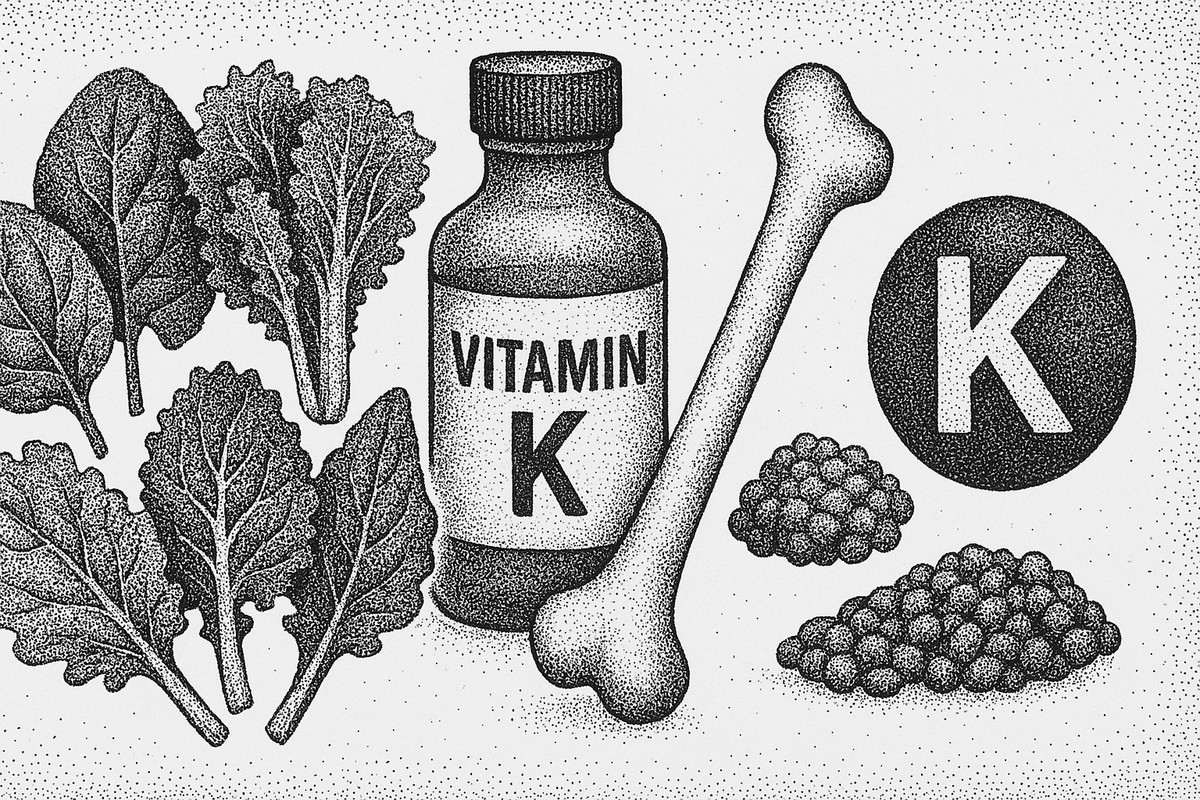Vitamin K: The Clot Thickens (and Your Bones Strengthen)

What is Vitamin K?
Vitamin K is a group of fat-soluble vitamins essential for various bodily functions, particularly blood clotting and bone health. It is categorized into two main forms: vitamin K1 (phylloquinone), predominantly found in plant-based foods such as leafy greens, and vitamin K2 (menaquinone), which is present in animal products, fermented foods, and synthesized by gut bacteria. This distinction is important as it influences their dietary sources and potential health impacts, with research suggesting different absorption and distribution patterns in the body.
Functions in the Body
The body utilizes vitamin K to produce specific proteins required for blood clotting, a process critical for healing wounds and preventing excessive bleeding. These proteins, known as clotting factors, are synthesized in the liver with vitamin K as a cofactor. Additionally, vitamin K is vital for the carboxylation of osteocalcin, a protein that facilitates calcium binding in bones, thereby supporting bone mineralization and strength. Recent studies also explore its role in extrahepatic tissues, such as vascular health, where it may prevent calcium deposition in arteries, though this is still under investigation.
Health Benefits
The benefits of vitamin K are primarily centered around its role in hemostasis and skeletal health. It is well-established that adequate vitamin K intake helps prevent vitamin K deficiency bleeding, especially in newborns, and supports bone density, potentially reducing the risk of osteoporosis. Emerging research, particularly on vitamin K2, suggests it may offer cardiovascular benefits by inhibiting arterial calcification, with a 2019 meta-analysis linking higher K2 intake to a reduced risk of coronary heart disease (Vitamin K2: What It Is and Its Benefits). However, the evidence for these additional benefits is not yet conclusive, and more studies are needed to confirm their extent.
Recommended Daily Intake and Average Consumption
The Adequate Intake (AI) for vitamin K, as established by the National Institutes of Health, is 120 mcg per day for men and 90 mcg per day for women aged 19 and older, reflecting the amount needed to maintain blood clotting and bone health without sufficient evidence for a Recommended Dietary Allowance (RDA) (Vitamin K - The Nutrition Source). This AI is based primarily on vitamin K1 intake, given its prevalence in diets.
Average consumption varies by age group. Data from nutritional surveys, such as those cited in a 2003 ScienceDirect article, indicate that young adults typically consume about 80 mcg per day, which may be below the AI for men, while older adults average around 150 mcg per day, often exceeding the AI (Dietary Intake and Adequacy of Vitamin K). These figures suggest dietary habits may improve with age, possibly due to increased vegetable consumption, though individual intakes can vary widely based on diet.
Food Sources and Their Vitamin K Content
Vitamin K is readily available in a variety of foods, with green leafy vegetables being the richest sources of vitamin K1, and fermented foods and animal products providing vitamin K2. Below is a detailed table of foods high in vitamin K, based on reliable nutritional databases:
These values are derived from the USDA National Nutrient Database and other reliable sources, such as Vitamin K Foods: 20 Tasty, Nutritious Options, ensuring accuracy for dietary planning. Notably, foods like natto, a fermented soybean product, are unexpectedly high in vitamin K2, which may be less familiar to Western diets but is a staple in Japanese cuisine, highlighting cultural dietary differences.
Conclusion and Practical Implications
Vitamin K is a vital nutrient with significant roles in blood clotting and bone health, and potentially broader benefits for cardiovascular health. Ensuring adequate intake through a diet rich in leafy greens, cruciferous vegetables, and fermented foods can help meet the AI, particularly for those with lower consumption levels. For individuals on medications like warfarin, maintaining consistent vitamin K intake is crucial, as it can affect blood thinning effects (VITAMIN K: Overview, Uses, Side Effects, Precautions, Interactions, Dosing and Reviews). This comprehensive understanding underscores the importance of dietary diversity to leverage the full spectrum of vitamin K's health benefits.

Comments ()